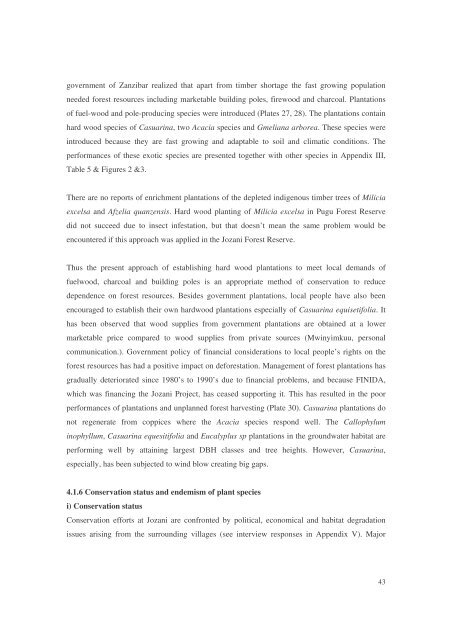Jozani biodiversity inventory report 2002 - Coastal Forests of Kenya ...
Jozani biodiversity inventory report 2002 - Coastal Forests of Kenya ...
Jozani biodiversity inventory report 2002 - Coastal Forests of Kenya ...
Create successful ePaper yourself
Turn your PDF publications into a flip-book with our unique Google optimized e-Paper software.
government <strong>of</strong> Zanzibar realized that apart from timber shortage the fast growing population<br />
needed forest resources including marketable building poles, firewood and charcoal. Plantations<br />
<strong>of</strong> fuel-wood and pole-producing species were introduced (Plates 27, 28). The plantations contain<br />
hard wood species <strong>of</strong> Casuarina, two Acacia species and Gmeliana arborea. These species were<br />
introduced because they are fast growing and adaptable to soil and climatic conditions. The<br />
performances <strong>of</strong> these exotic species are presented together with other species in Appendix III,<br />
Table 5 & Figures 2 &3.<br />
There are no <strong>report</strong>s <strong>of</strong> enrichment plantations <strong>of</strong> the depleted indigenous timber trees <strong>of</strong> Milicia<br />
excelsa and Afzelia quanzensis. Hard wood planting <strong>of</strong> Milicia excelsa in Pugu Forest Reserve<br />
did not succeed due to insect infestation, but that doesn’t mean the same problem would be<br />
encountered if this approach was applied in the <strong>Jozani</strong> Forest Reserve.<br />
Thus the present approach <strong>of</strong> establishing hard wood plantations to meet local demands <strong>of</strong><br />
fuelwood, charcoal and building poles is an appropriate method <strong>of</strong> conservation to reduce<br />
dependence on forest resources. Besides government plantations, local people have also been<br />
encouraged to establish their own hardwood plantations especially <strong>of</strong> Casuarina equisetifolia. It<br />
has been observed that wood supplies from government plantations are obtained at a lower<br />
marketable price compared to wood supplies from private sources (Mwinyimkuu, personal<br />
communication.). Government policy <strong>of</strong> financial considerations to local people’s rights on the<br />
forest resources has had a positive impact on deforestation. Management <strong>of</strong> forest plantations has<br />
gradually deteriorated since 1980’s to 1990’s due to financial problems, and because FINIDA,<br />
which was financing the <strong>Jozani</strong> Project, has ceased supporting it. This has resulted in the poor<br />
performances <strong>of</strong> plantations and unplanned forest harvesting (Plate 30). Casuarina plantations do<br />
not regenerate from coppices where the Acacia species respond well. The Callophylum<br />
inophyllum, Casuarina equesitifolia and Eucalyplus sp plantations in the groundwater habitat are<br />
performing well by attaining largest DBH classes and tree heights. However, Casuarina,<br />
especially, has been subjected to wind blow creating big gaps.<br />
4.1.6 Conservation status and endemism <strong>of</strong> plant species<br />
i) Conservation status<br />
Conservation efforts at <strong>Jozani</strong> are confronted by political, economical and habitat degradation<br />
issues arising from the surrounding villages (see interview responses in Appendix V). Major<br />
43
















